
George Inness was an American landscape painter.
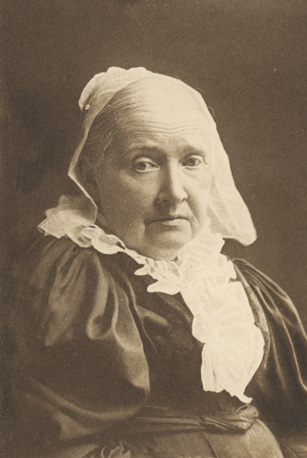
Julia Ward Howe was an American author and poet, known for writing the "Battle Hymn of the Republic" as new lyrics to an existing song, and the original 1870 pacifist Mothers' Day Proclamation. She was also an advocate for abolitionism and a social activist, particularly for women's suffrage.

Winslow Homer was an American landscape painter and illustrator, best known for his marine subjects. He is considered one of the foremost painters of 19th-century America and a preeminent figure in American art in general.

William Morris Hunt was an American painter.

The Gulf Stream is an 1899 oil painting by the American artist Winslow Homer. It shows a man in a small dismasted rudderless fishing boat struggling against the storm-tossed waves and perils of the sea, presumably near the Gulf Stream, and was the artist's statement on a theme that had interested him for more than a decade. During the time he explored this theme, Homer, a New Englander, boated often near Florida, Cuba, and the Caribbean.
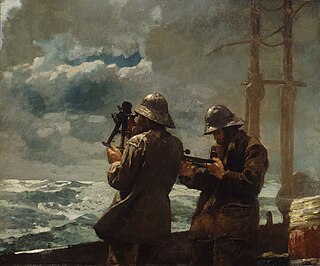
Eight Bells is an 1886 oil painting by the American artist Winslow Homer. It depicts two sailors determining their ship's latitude. It is one of the Homer's best-known paintings and the last of his major paintings of the 1880s that dramatically chronicle man's relationship to the ocean.
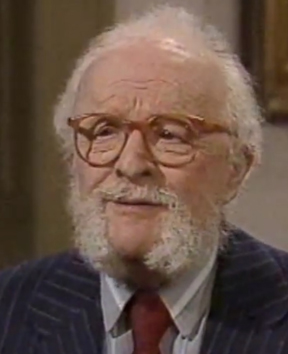
James Thomas Flexner was an American historian and biographer best known for the four-volume biography of George Washington that earned him a National Book Award in Biography and a special Pulitzer Prize. His one-volume abridgment, Washington: the Indispensable Man (1974) was the basis of two television miniseries, George Washington (1984) and George Washington II: The Forging of a Nation (1986), starring Barry Bostwick as Washington.
Harold Trowbridge Pulsifer was an American poet and magazine editor.

Right and Left is a 1909 oil on canvas painting by the American artist Winslow Homer. It depicts a pair of common goldeneye ducks at the moment they are hit by a hunter's shotgun blast as they attempt to take flight. Completed less than two years before his death, it was Homer's last great painting, and has been the subject of a variety of interpretations regarding its origin, composition and meaning. As with his other late masterworks, it represents a return to the sporting and hunting subjects of Homer's earlier years, and was to be his final engagement with the theme. Its design recalls that of Japanese art, and the composition resembles that of a colored engraving by John James Audubon.

Breezing Up (A Fair Wind) is an oil painting by American artist Winslow Homer. It depicts a catboat called the Gloucester chopping through that city's harbor under "a fair wind" (Homer's original title). Inside the boat are a man, three boys, and their catch.

A Visit from the Old Mistress is an 1876 painting by the American artist Winslow Homer. It was one of several works that Homer is thought to have created during a mid-1870s visit to Virginia, where he had served for a time as a Union war correspondent during the American Civil War. Scholars have noted that the painting's composition is taken from Homer's earlier painting Prisoners from the Front, which depicts a group of captive Confederate soldiers defiantly regarding a Union officer. Put on display in the northern states for a northern audience, A Visit from the Old Mistress, along with Homer's other paintings of black southern life from the Reconstruction era, has been praised as an "invaluable record of an important segment of life in Virginia during the Reconstruction."
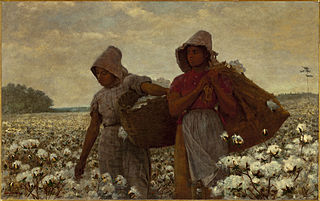
The Cotton Pickers is an 1876 oil painting by the American artist Winslow Homer. It depicts two young African-American women in a cotton field.
Stately, silent and with barely a flicker of sadness on their faces, the two black women in the painting are unmistakable in their disillusionment: they picked cotton before the war and they are still picking cotton afterward.

The Fog Warning is one of several paintings on marine subjects by the late-19th-century American painter Winslow Homer (1836–1910). Together with The Herring Net and Breezing Up, painted the same year and also depicting the hard lives of fishermen in Maine, it is considered among his best works on such topics.
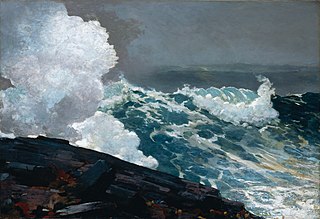
Northeaster is one of several paintings on marine subjects by the late-19th-century American painter Winslow Homer. Like The Fog Warning and Breezing Up, he created it during his time in Maine. It is on display in the Metropolitan Museum of Art in New York. Viewers are presented a struggle of elements between the sea and the rocky shore. Winslow Homer excelled in painting landscape paintings that depicted seascapes and mountain scenery.

Cannon Rock is an 1895 oil painting by the American artist Winslow Homer. It is part of the Metropolitan Museum of Art's collection.
Daisy Blanche King (1875–1947) was an American painter and sculptor.

Moonlight, Wood Island Light is a late 19th-century oil painting by American artist Winslow Homer. The painting is in the collection of the Metropolitan Museum of Art in New York.

Sarah Helena de Kay Gilder was an American painter, illustrator, and cultural tastemaker from New York City.

The Veteran in a New Field is an oil-on-canvas painting by the 19th-century American artist Winslow Homer. It is set in the aftermath of the American Civil War and is often interpreted as an emblem of postwar American society. The painting depicts a farmer harvesting wheat in a field with a scythe. The farmer in the painting is identified as a former Union soldier from his discarded jacket and canteen in the right foreground of the painting. This painting was one of several that Homer did on the American Civil War, including his previous works Home, Sweet Home and Prisoners from the Front. The Veteran in a New Field is a transitional painting in Homer's body of work. It comments on the postwar return of soldiers to daily life and the history of death that they bring along with them. It uses biblical themes to comment on war and nature, while also alluding to stories from classical history.

Grace Hoops is a genre painting by the American artist Winslow Homer. It depicts two young women outdoors playing the game of graces. Scenes of childhood innocence constituted one of Homer's recurring subjects throughout the 1870s. The work is now in the collection of the McMullen Museum of Art at Boston College, having been donated as part of the Carolyn A. and Peter S. Lynch collection.


















